ZAP MAMA / “Belgo Zaïroise”
In 1991, Zap Mama recorded and released their first album for the Belgium indie label Crammed. Two years later, that same music was repackaged and reissued on David Byrne’s Luaka Bop label as Adventures In Afropea Volume 1. For most American fans including me, Adventures In Afropea was the introduction to the group.
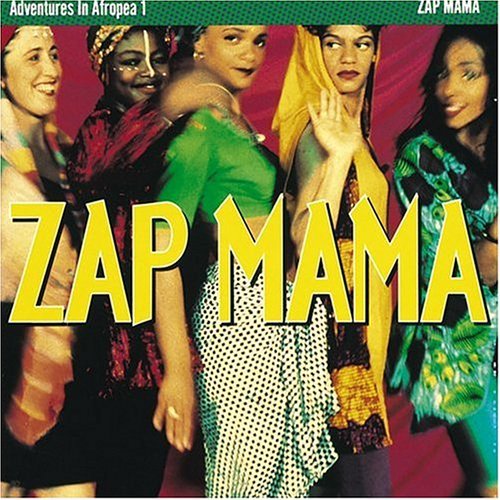
The cover photo of the Luaka Bop reissue features five colorfully-dressed women of obviously different races and cultural backgrounds. None of them appear to take precedence over the others. It’s impossible to tell who—if any of them—is the leader of the group. In fact, if you don’t already know who Marie Daulne is, it’s difficult to pick her out at all. (Marie, the de facto leader of the quintet, is the smiling face all the way to the right, half of her body cut off by the end of the frame.) The music sounds a lot like the cover looks. It’s a vibrant, multi-cultural mix of various African and European a capella sounds and musical traditions. The album is almost 100% vocal – there are virtually no sounds on the album other than the singers’ voices. Harmonically, the five women couldn’t be better suited to one another. Their singing is magnificent, their harmonies are stunning. If I have any criticism at all, it’s that the songwriting isn’t as well-developed as it could (and eventually would) be. Some of the songs have an improvised, demo-ish feel. I have to say though that the better pieces are among the best a capella songs I’ve ever heard performed by anyone.
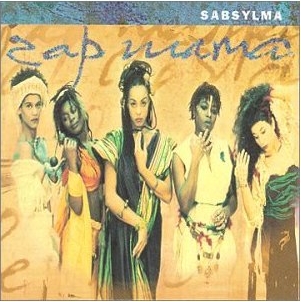
Zap Mama released their second album Sabsylama in 1994. Again, all five women are pictured and posed more or less equally. This time though there is a subtle separation between Marie and her four bandmates. Marie is upfront and in the center. The other singers are placed ‘around’ Marie instead of with her. Also, unless it’s just my imagination, the other four look a little fuzzy and indistinct whereas Marie’s photo looks sharp and clear. (Then again, it also seems to be a single group photo, so who knows.) The music is largely a continuation of the sound and style of the first album. One significant difference is the addition of acoustic percussion instruments. Still, the musical focus is on the voices and the group dynamic. The harmonies are as strong as ever although the music as a whole has an angular, tougher sound than did the first album. Marie says this was the result of constant touring. About Zap Mama’s debut recording, she says: “[It] was a soft, African record with a natural, round sound. Sabsylma is hectic, sharper. Not on purpose, mind you. I can't help it. If you're driving in a van for months, and you constantly hear the sounds of traffic, TV, hardrock on the radio...those sounds hook up in your ears, and come out if you start to sing.”
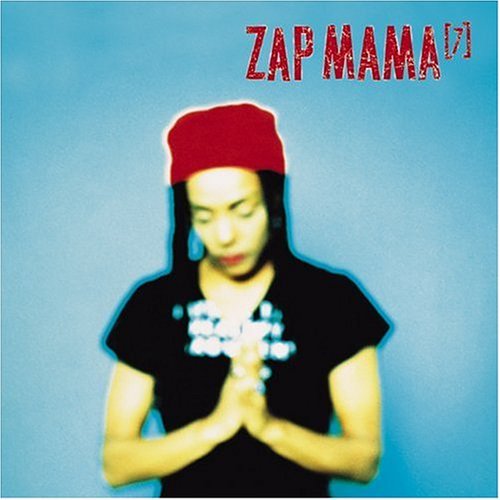
Zap Mama released their third album 7 in 1997 on Luaka Bop/Warner Bros. It signaled a major shift in the Zap Mama approach, both in imagery and in sound. The cover features Marie only. I guess that made practical sense since I’m fairly certain that only one of the singers from the original lineup remained. (Other than Marie herself, of course. And I don’t have my CDs with me so I can’t check the lineup details to be certain.) Also, if I’m not mistaken, this was the album that first announced, rather ominously: “Marie Daulne is Zap Mama.” It’s on this third album that Marie came into her own as a songwriter. Of course I may be biased because this is also the first Zap Mama album featuring 100% English-language songs. In my own defense though, some of favorite songs of the album aren’t sung in English. Listening to 7, it’s impressive that Zap Mama sounds so good singing with a full band after having spent the previous six years singing almost completely a cappela. The songwriting is tight, the band is funky and Marie’s voice never sounded better. In sum, this is a great, great album.
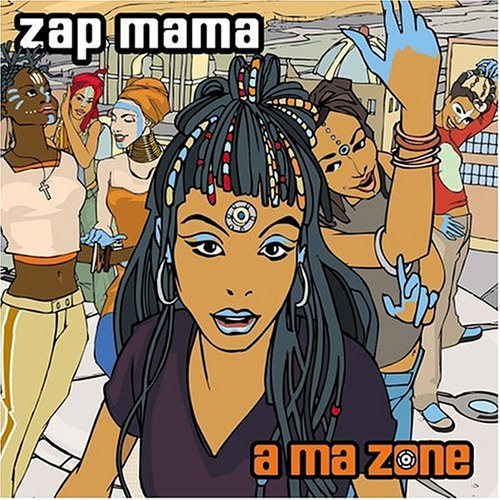
Zap Mama’s fourth album was A Ma Zone. It dropped in 1999 on Luaka Bop/Warner Bros. Again, the cover primarily featured Marie, but in this case she was part of a conceptualized anime-looking ‘future world.’ It’s a very creative piece of artwork and probably my favorite Zap Mama album cover. Again though, looking at the cover it’s not hard to figure who the focus of Zap Mama is. In fact, I don’t know whether the other figures are actually part of the group or are just inventions of the graphic artist. Musically, Marie seems to be continuing a pattern of doing albums in twos as A Ma Zone sounds like a continuation of 7. Just as Sabyslama sounded like a sharper, more modern take on the vibe of Adventures, A Ma Zone sounds almost like an electronica remix of 7. At times, most notably the frequent drum ‘n bass excursions, that’s a very good thing. Although we’re now light years away from the original Zap Mama sound, A Ma Zone is home to some of my favorite Zap Mama songs. As long as you don’t get caught up in lamenting the now-certain passing of the original a capella sisterhood, you’ll find that A Ma Zone is a very enjoyable contemporary album.
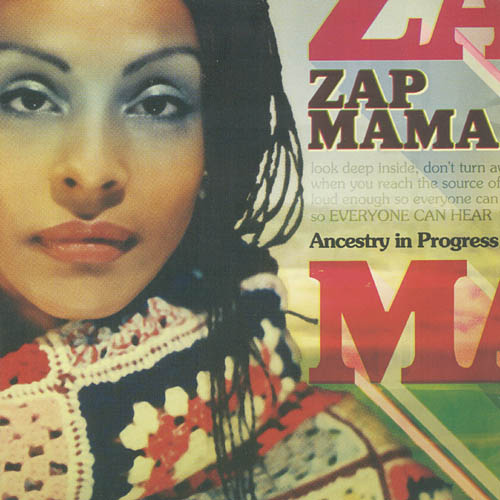
In 2004, Zap Mama released their fifth album, Ancestry In Progress. (By this point though it’s getting difficult to continue referring to them as ‘them.’) For the first time, Marie and Marie alone is ‘featured’ on the album cover. Of course Marie had been pictured virtually by herself on the previous two albums, but on the cover of 7 the photo was a hazy, abstract-looking image; likewise, the artwork for A Ma Zone was clearly intended to make a conceptual statement. In both cases, it could be argued that the choice was artistic rather than egoistic. There’s no such ambiguity about the cover art of Ancestry In Progress. It’s an unambiguous head-and-shoulders shot of Marie looking directly at the camera. I know it sounds like I’m complaining about the ever-increasing separation of Marie from her fellow musicians (and maybe I am), but I have to say this is a great CD cover.
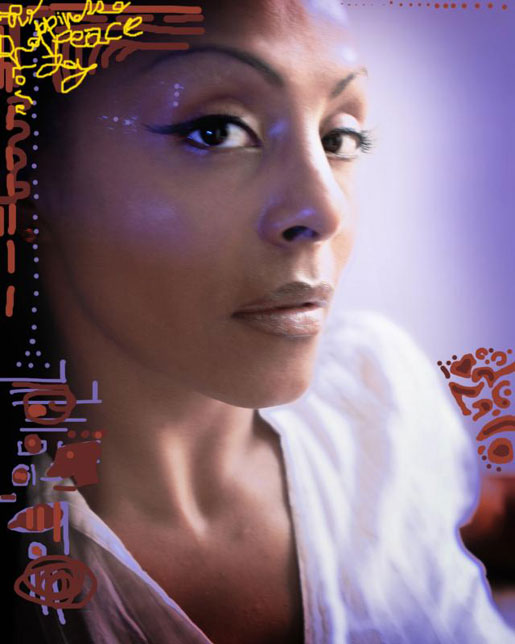
Marie is a unique-looking and quite beautiful woman. The photo ably captures both her beauty and the confident, upright way she carries herself. In the period between 7 and Ancestry In Progress, Marie relocated to America and you can hear the difference in the music. For the first time, Marie included hip-hop elements into the sound mix, including the use of guest rappers Talib Kweli, Common and Bahamadia. As music critic Ted Hendrickson commented, “Instead of the African jungle we get the urban jungle, but it’s still beautiful music.” In the broadest sense, I agree, but despite a number of strong songs this was the first Zap Mama album I didn’t enjoy from beginning to end. The high points—for example: “Ça Varie,” (which I already knew from an earlier remix EP), “Wadidyusay?” and the still-stunning “Bandy Bandy”—were very high, but for my tastes, the Zap Mama sound was beginning to lean too heavily to the contemporary.
The 7 album was so good, and the A Ma Zone album nearly as good, because Marie was able to balance the early Afro-European style of Zap Mama with the new contemporary instrumentation. With Ancestry In Progress, it sounded for the first time like Marie was losing that balance. The scale had begun to tip.
For tracks from Ancestry In Progress and the rest of this story see this week’s Contemporary post.
Get your classic Zap Mama here:
- From Zap Mama (Crammed, 1991), reissued as Adventures In Afropea, Vol. 1 (Luaka Bop, 1993): “Mupepe,” “Take Me Coco” and “Guzophela”
- From Sabsylama (Luaka Bop, 1994): “Mais Qu’est-Ce?,” “Citoyen 120,” “The Mamas Of The Mamas”
- From 7 (Luaka Bop/Warner Bros, 1997): “Belgo Zaïroise,” “Nostalgie Amoureuse” and “Jogging À Tombouctou”
- From A Ma Zone (Luaka Bop/Warner Bros, 1999): “Call Waiting,” “Songe” and “’Allo ‘Allo”
—Mtume ya Salaam
Sometimes it’s impossible
But we try, nonetheless, because eventually, or should I say “occasionally,” we actually achieve the impossible.
We’ve seen this picture before.Brothers and sisters, please welcome the Supremes!
Ladies and gentlemen, we present: Diana Ross and the Supremes!
Beautiful people, put your hands together for “the Boss, Diana Ross!”
Capitalism prefers the individual over the group. In the music industry (usually sooner rather than later) the group gets busted up and one individual is selected to be pushed to the fore. The apotheosis of this syndrome being, depending on your particular musical tastes, either The Wailers or The Beatles.
I know, I know, someone is going to point out that there never was one leading Beatle—without getting into a major argument about who was the lead Beatle, it’s clear that the quartet’s most noted demise is based on the departure of John Lennon, who was, by media exposure, the most noted Beatle until his assassination. (Let’s not use the euphemism “untimely demise” as if he died of natural causes, nor should we succumb to the equally obnoxious roundabout “tragic death,” as if it were a plane accident or drug-induced suicide). My point remains: the industry is always in search of a cash cow, singular. They do not like herds: too costly to maintain, too many headaches to sort out, etc. etc.
Thus the devolution of Zap Mama from a group to a solo act is no surprise.
However, the movement towards solo stardom is not the touchy issue. Nor is the emphasis on the mixed race as the paragon of colored beauty. (If you can’t be white be mixed!) Besides it is such a terrible trap for those of us who are of visibly mixed heritage. On an individual level, race is meaningless but in the local social context, racial identity is weighed down with all sorts of freight that is completely external to a particular individual.
Marley’s father may have been a British officer but Bob wasn’t waving no Union Jack. So, no, it is not the racial identity of the individual that is the major issue even though it does sometimes become a major individual issue beyond the already numbing social contradictions of mixed racial background, particularly in America where race runs through every aspect of society even as the society proclaims itself to now be beyond race.
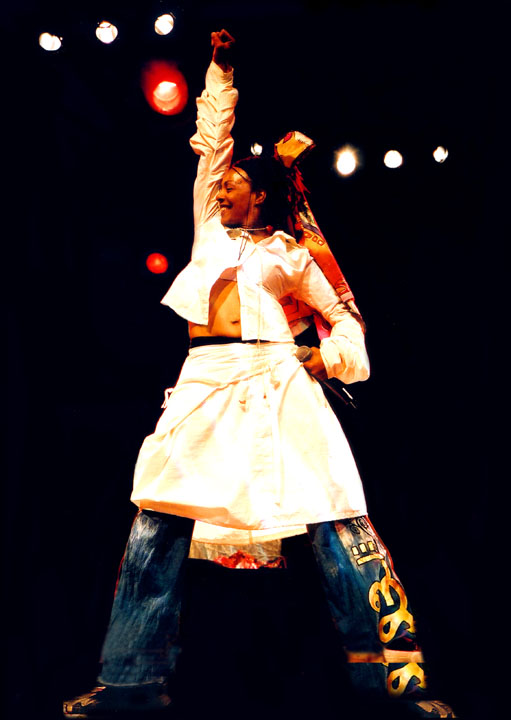
From my perspective, cultural identification and social consciousness are the more important considerations, and are also the yardsticks I use to plot Zap Mama’s development. Like Mtume I most enjoy the music from the middle period, the period of tension and contradiction, a music that was not simply repetitive of a specific heritage nor was it unmoored to a cultural tradition. Both 7 and A Ma Zone successfully walk the line, a line that is like a tightrope with no net below.
When you come from two worlds it is impossible to cut out one from the other; we might emphasize one heritage more than the other but we remain creatures shaped by both. In Zap Mama’s case there is both Belgium and Zaire (AKA at that time 'the Congo') and it’s all there, except we must be careful to note that neither element is there simply as a stereotype. Moreover, in Zap Mama’s case, the Zaire heritage had to be consciously sought even though the seed of it was planted during infancy.
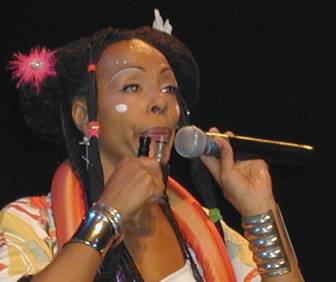
Listening to all of the African musical techniques that Zap Mama employs one might be tempted to think of her musicality as solely a natural expression. I think not. Marie Daulne consciously studied her heritage music; lived amongst and learned from her mother’s people. Being is not the same as understanding. We can “be” (i.e. exist) without having any hard and/or historical knowledge about who and what we are.
To grapple with our heritage is necessary but not sufficient. We do not live in the past, we live in the now. How do we respond to the contemporary? That is the second half of the infernal “who am I?” question. The nexus of where we came from influencing how we deal with where we are determines who we actually are, who we can possibly become.
As Mtume laid it out, Zap Mama has offered us a fascinating musical record of this Third World journey, this discovery and celebration of roots while all the while searching for a definition of self that encompasses both the whole of where one comes from as well as all of where one hopes to go to, a wholeness which is fractured along colonized/indigenous, Western/non-Western fault lines, on both sides of which we have allegiances and loves as well as disagreements and bedevilments.
For me, even though I adore elements of the early work and admire some of the current work, 7 is the best of Zap Mama’s six recordings.
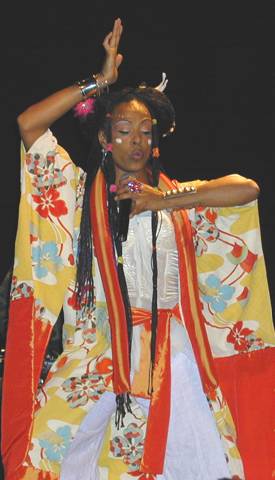
We are not at ease in our current world and Zap Mama reflects how unsettled we are. Hopefully, we will find firmer footing in the future but for now let us give thanks that Marie Dulne has been so willing to excavate her heritage and use the results in envisioning a comprehensive future.
Appropriately, “to zap” is French slang for “to change” as in use a remote to “zap,” or change channels on a television. Or, zapping could be a cultural statement to move from one placement to another.
We are still in the air; although some probabilities may be plotted it is nevertheless impossible to assert with certainty where we will land or, if indeed, we will actually ever land for any significant length of time. Perhaps our path is to flow and float, momentarily touching here and there but spending the majority of our existence on the wing, in the air: hovering, soaring, gliding, diving but always moving.
—Kalamu ya Salaam
P.S. Mtume, a couple of afterthoughts.
1. Zap Mama recorded 7 after a short haitus during which she had a baby. The original group was not reformed, plus (if the references are reliable) Marie Daulne had also spent time living in Mali. Although I'm certain there was an industry push toward going solo, I'm pretty certain that was not the main motivation for 7 being virtually a one-woman recording.2. Ancestry was not the first time hip-hop elements were incorporated into the Zap Mama sound. A Ma Zone included contributions from The Roots and Speech of Arrested Development.
The trajectory of muscial development is rarely the straight line plotting album-to-album may seem. There are so many influences that are not apparent, so many influences and determinants. We are, of course, most often merely speculating using the albums as the most accessable information but there is always a bunch of extra-musical elements that must be taken into consideration. Also artists will invariably start on one road and then return to start over on another road.
Marie Daulne moved to New York and immediately felt at home. Three years later she was back in Belgium, proclaiming Belgium much better for her than New York. Similarly her choice of musicians with whom to make music is also subject to diverse influences and intentions, all of which invariably changes over time.
This entry was posted on Sunday, November 11th, 2007 at 2:40 am and is filed under Classic. You can follow any responses to this entry through the RSS 2.0 feed. You can leave a response, or trackback from your own site.
2 Responses to “ZAP MAMA / “Belgo Zaïroise””
November 14th, 2007 at 7:09 pm
When I was in L.A., the public radio station was raving about this group. Now I see why. Thanks.
November 15th, 2007 at 4:20 pm
Sweet Honey In The Rock, or more notably Ladysmith Black Mambazo, Zap Mama isn’t. However, I can use them all in the same sentence as they have mastered harmonizing acappella. What makes Zap Mama different than Sweet Honey, Ladysmith, Take 6, and others is that indeed a singleton star was cultivated. In listening to the music, can you pick out Marie Daulne’s individual contribution or the harmony?
I can’t. But then this is the first I’ve heard of the group. What I’m saying is that harmonically and aurally can you imagine the group without Marie? I can if the voices remain in harmony. No disrespect to Marie either. I just don’t hear individuals…I hear a chorus.
The music is beautiful. Man, I’ve gotta learn French.
P.S., Guzophela sounds like it is running at slow speed.
Leave a Reply
| top |